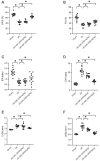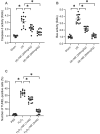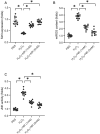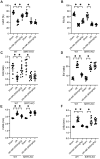Nicotinamide Riboside-Driven Modulation of SIRT3/mtROS/JNK Signaling Pathways Alleviates Myocardial Ischemia-Reperfusion Injury
- PMID: 39239543
- PMCID: PMC11373543
- DOI: 10.7150/ijms.97530
Nicotinamide Riboside-Driven Modulation of SIRT3/mtROS/JNK Signaling Pathways Alleviates Myocardial Ischemia-Reperfusion Injury
Abstract
Myocardial ischemia-reperfusion (I/R) injury exacerbates cellular damage upon restoring blood flow to ischemic cardiac tissue, causing oxidative stress, inflammation, and apoptosis. This study investigates Nicotinamide Riboside (NR), a precursor of nicotinamide adenine dinucleotide (NAD+), for its cardioprotective effects. Administering NR to mice before I/R injury and evaluating heart function via echocardiography showed that NR significantly improved heart function, increased left ventricular ejection fraction (LVEF) and fractional shortening (FS), and reduced left ventricular end-diastolic (LVDd) and end-systolic diameters (LVSd). NR also restored E/A and E/e' ratios. It reduced cardiomyocyte apoptosis both in vivo and in vitro, inhibiting elevated caspase-3 activity and returning Bax protein levels to normal. In vitro, NR reduced the apoptotic rate in hydrogen peroxide (H2O2)-treated HL-1 cells from 30% to 10%. Mechanistically, NR modulated the SIRT3/mtROS/JNK pathway, reversing H2O2-induced SIRT3 downregulation, reducing mitochondrial reactive oxygen species (mtROS), and inhibiting JNK activation. Using SIRT3-knockout (SIRT3-KO) mice, we confirmed that NR's cardioprotective effects depend on SIRT3. Echocardiography showed that NR's benefits were abrogated in SIRT3-KO mice. In conclusion, NR provides significant cardioprotection against myocardial I/R injury by enhancing NAD+ levels and modulating the SIRT3/mtROS/JNK pathway, suggesting its potential as a novel therapeutic agent for ischemic heart diseases, meriting further clinical research.
Keywords: JNK; Nicotinamide Riboside; SIRT3; cardiac ischemia reperfusion injury.; mtROS.
© The author(s).
Conflict of interest statement
Competing Interests: The authors have declared that no competing interest exists.
Figures




Similar articles
-
Nicotinamide riboside attenuates myocardial ischemia-reperfusion injury via regulating SIRT3/SOD2 signaling pathway.Biomed Pharmacother. 2024 Jun;175:116689. doi: 10.1016/j.biopha.2024.116689. Epub 2024 May 3. Biomed Pharmacother. 2024. PMID: 38703508
-
Salvianolic acid B alleviated myocardial ischemia-reperfusion injury via modulating SIRT3-mediated crosstalk between mitochondrial ROS and NLRP3.Phytomedicine. 2025 Jan;136:156260. doi: 10.1016/j.phymed.2024.156260. Epub 2024 Nov 14. Phytomedicine. 2025. PMID: 39579610
-
Insulin and glycolysis dependency of cardioprotection by nicotinamide riboside.Basic Res Cardiol. 2024 Jun;119(3):403-418. doi: 10.1007/s00395-024-01042-4. Epub 2024 Mar 25. Basic Res Cardiol. 2024. PMID: 38528175 Free PMC article.
-
Nicotinamide Adenine Dinucleotide Supplementation to Alleviate Heart Failure: A Mitochondrial Dysfunction Perspective.Nutrients. 2025 May 29;17(11):1855. doi: 10.3390/nu17111855. Nutrients. 2025. PMID: 40507126 Free PMC article. Review.
-
Roles of SIRT3 in heart failure: from bench to bedside.J Zhejiang Univ Sci B. 2016 Nov.;17(11):821-830. doi: 10.1631/jzus.B1600253. J Zhejiang Univ Sci B. 2016. PMID: 27819129 Free PMC article. Review.
Cited by
-
Effects of Nicotinamide Riboside Supplementation on Postmortem Mitochondrial Functionality and Apoptotic Activation.Metabolites. 2025 Jan 8;15(1):31. doi: 10.3390/metabo15010031. Metabolites. 2025. PMID: 39852374 Free PMC article.
-
The role of NAD+ metabolism and its modulation of mitochondria in aging and disease.NPJ Metab Health Dis. 2025 Jun 18;3(1):26. doi: 10.1038/s44324-025-00067-0. NPJ Metab Health Dis. 2025. PMID: 40604314 Free PMC article. Review.
References
-
- Chereshnev V. Targeting neutrophil subsets is a novel approach for myocardial ischemia-reperfusion injury. Sci Bull (Beijing) 2024. - PubMed
-
- Yaghoobi A, Rezaee M, Hedayati N, Keshavarzmotamed A, Khalilzad MA, Russel R, Insight into the cardioprotective effects of melatonin: shining a spotlight on intercellular Sirt signaling communication. Mol Cell Biochem. 2024. - PubMed
-
- Wu Y, Zou Y, Song C, Cao K, Cai K, Chen S. et al. The role of serine/threonine protein kinases in cardiovascular disease and potential therapeutic methods. Biomed Pharmacother. 2024;177:117093. - PubMed
MeSH terms
Substances
LinkOut - more resources
Full Text Sources
Research Materials

